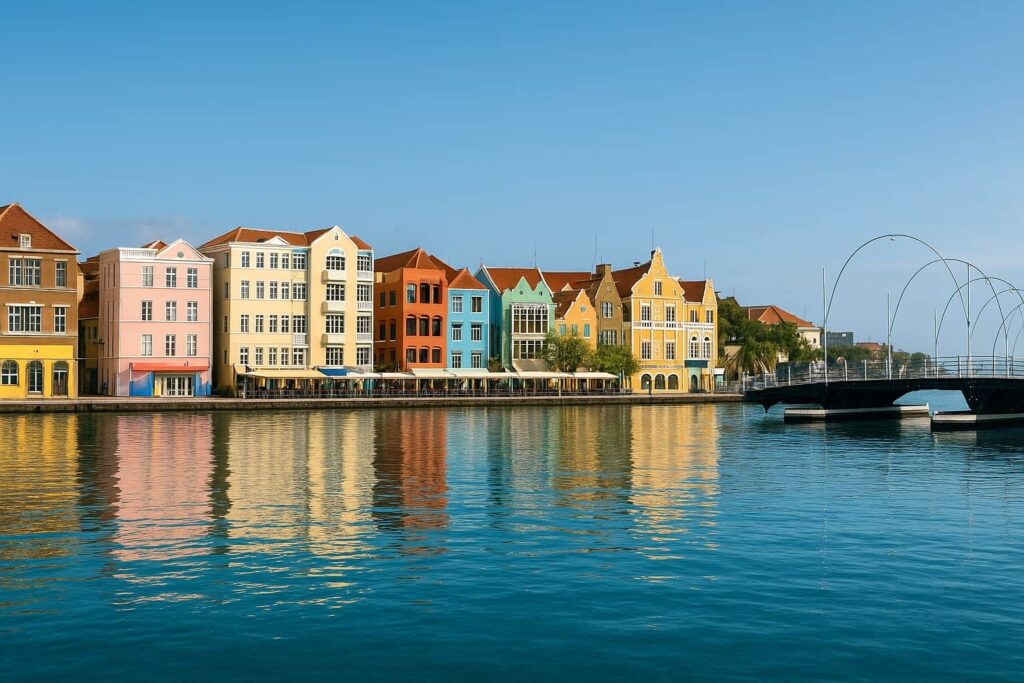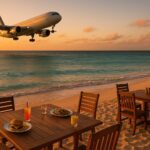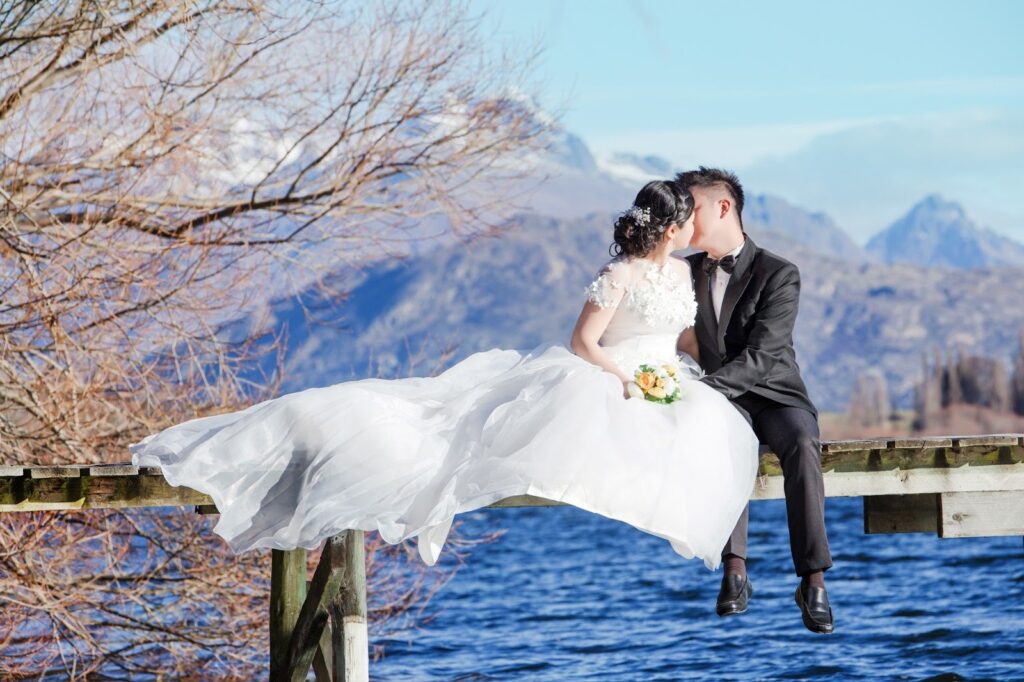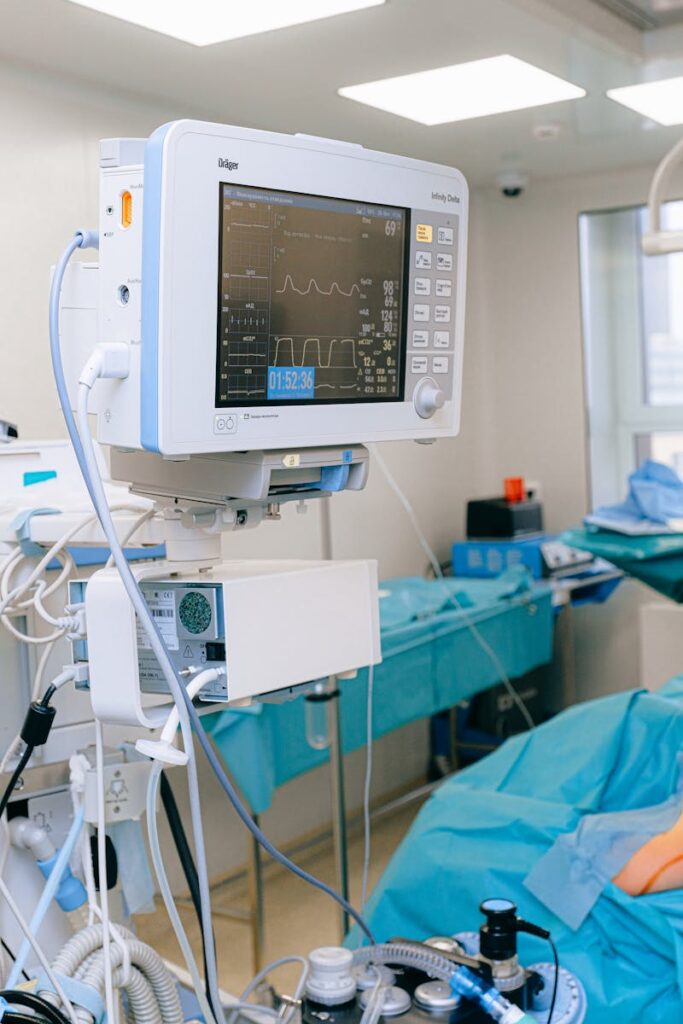Planning an Outdoor Photoshoot in Curaçao starts with light and distance. Pastel streets, calm bays, and rugged cliffs sit minutes apart. You can shoot city pastels at sunrise, then clear water and cliffs before sunset. Here is the game plan.
- Aim for early morning or late afternoon for soft, clean light.
- Pack a reflector, a polarizer, and a trusty microfiber cloth.
- Choose two close locations to keep energy high and travel light.
- Build ten-minute buffers so you can breathe, reset, and stay on pace.
Keep the plan simple and the bag light. Capture one wide scene, one tight portrait, and one candid movement at each stop. Let color, breeze, and easy pacing carry your frames.
1) Handelskade and Queen Emma Bridge
Begin at the harbor where pastel facades hug the water and the pontoon bridge adds gentle motion. Grab a coffee, watch the bridge swing open, and choose your first frame without hunting for a backdrop.
- Best light: Early morning for calm streets, blue hour for reflections.
- Angles: From the bridge toward Handelskade, from Otrabanda back to the facades, or in doorways for natural frames.
- Tips: Work fast when cruise crowds arrive and wipe sea spray as you move.
Finish this stop with one wide scene-setter, one close portrait, and a candid walking frame. If the crowds build, slip into a side street for shade, wipe the lens, and head to your next spot with momentum.
2) Playa Kenepa Grandi (Grote Knip)
Pull into the small cliffside lot and take the stairs to the lookout. The water shifts from pale mint to deep blue and the curve of the bay gives you an easy wide frame. Start with a high-angle shot for scale, then walk down to the sand for soft backlight.
- Best light: Late afternoon into golden hour.
- Angles: Wide from the lookout, low on the shoreline with surf as a guide, waist-deep backlit portraits on calm days.
- Tips: Bring a diffuser for midday fill and sandals that slip off quickly.
Work in short sets near the shoreline for clean, bright reflections. Rinse the sand, slip on sandals, and head to the next spot while the light stays warm.
3) Shete Boka National Park
Pull up to the park and you can hear the surf before you see it. The dark rock, spray, and low rumble set the mood right away. Keep the kit simple, find a solid footing, and let the coastline’s texture do the heavy lifting.
- Best light: Early morning or overcast for even tones on the rock.
- Angles: Diagonals along the coast, wide scenes with your subject on a stable ledge, slow shutter for water trails when wind is low.
- Safety: Stay clear of wet edges and active blowholes. Closed-toe shoes help.
Work fast, then pause for a quick safety check. Grab a shoreline diagonal, a wide ledge frame, and, if the wind eases, a slow-shutter water trail; wipe the salt, swap to dry shoes, and head out before the heat builds.
4) Jan Kok Salt Pans and Flamingo Lookout
Soft pinks and pale whites flatter skin tones. Flamingos may pass through, so think of them as a bonus rather than the reason to visit.
- Best light: Sunset for pastel reflections.
- Angles: Subject on firm edges with still water behind, reflector lift from the shadow side, telephoto if birds arrive.
- Tips: Bring repellent at dusk and stick to paths to protect the flats.
Keep movements gentle and frames clean: one calm edge portrait, one sunset reflection, and a distant telephoto if birds appear. Pack the reflector, shake out the sand, and head out before the bugs wake up.
5) Christoffel National Park
Arrive at first light when the air is cool and the trails are quiet. Cactus silhouettes pop against the sky, so warm up in the shade before heading toward an overlook.
- Best light: Sunrise for cooler temps and clean views.
- Angles: Cactus foregrounds for depth, clean horizon lines on trail shots, wide summit frames that include coastline.
- Prep: Water, sturdy shoes, and a lean kit. A fast prime plus a wide lens is enough.
Keep sets short and the pack light so you stay fresh. Grab your last wide view, sip water, and roll out before the heat builds.
What to Wear and Bring
Keep choices simple so faces and light lead the frame. Pick colors that play well with blue water and pastel walls. Pack light, move easily, and your photos will feel effortless.
- Wardrobe: Coral, teal, mustard, cream, or crisp white. Choose breathable fabrics that move. Skip tiny high-contrast patterns and loud logos.
- Props: Straw hat, light scarf, or a single tropical bloom. One prop per set keeps the look clean.
- Gear: Fast prime for portraits, a wide lens for scenes, circular polarizer, collapsible reflector, spare cards, spare batteries, and a microfiber cloth.
After each set, do a quick lint check, smooth fabric with a towel, and take a sip of water before the next location. Wear neutral sandals or clean sneakers you can slip off fast.
Pack reef-safe sunscreen and a small zip bag for sandy gear and phones. If humidity fogs your lens, let the kit acclimate for a few minutes before you start.
Timing Your Shoot
Plan around light, crowds, and wind. A little structure keeps the day smooth and gives you time to breathe between sets.
- Weekdays: Calmer in the city center.
- Morning: Softer light and fewer people.
- Late afternoon: Warmer cliffs and clearer water.
- Wind: Choose sheltered alleys or coves if gusts pick up.
Build a simple schedule with ten-minute travel buffers between stops. Leave room for one extra frame at each location in case the light turns perfect.
Posing That Always Works
Think motion over static poses. Give the hands a simple job and natural expressions will follow.
- Walk and glance: Take a few slow steps, look down, then glance up on a count of three.
- Seated angle: Sit on a step, turn shoulders slightly off-axis, relax the jaw.
- Hands in action: Hold a hat brim, adjust a sleeve, or fix a cuff for detail.
- Work the breeze: Face into the wind so hair lifts away from the face.
Review one or two frames after each set, align on what works, then move on. Keep posture tall, shoulders loose, and breathe so faces stay relaxed.
Leave No Trace
Treat every location like a shared studio. Pack light, move gently, and stay on marked paths. Your choices keep these spots open and beautiful.
- Use reef-safe sunscreen.
- Carry out all trash and tape.
- Give wildlife space and quiet.
- Respect signs and closing times.
Small habits protect the island for the next shoot. Keep your footprint low and your frames will still look pristine next season. Leave it better than you found it.
Sample Half-Day Route
You can cover two or three spots with time for water breaks and outfit changes.
- Sunrise at Handelskade for empty streets and pastel light.
- Midmorning at Grote Knip for water and sand portraits.
- Late afternoon at Jan Kok for pastel reflections and a calm close.
Swap Shete Boka or Christoffel is based on wind and fitness.
Ready to Book
If you want a photographer who knows these light windows and micro-angles, learn more here: Outdoor Photoshoot in Curaçao.






